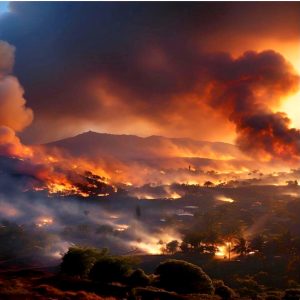“Future wildfires must be expected,” said Coconino County Flood Control District Administrator Lucinda Andreani.
The two studies – a pre-fire assessment of post-wildfire flood risk by JE Fuller Hydrology and Geomorphology and an economic impact study by NAU’s Economic Policy Institute – provide an unsettling calculation of how wildfire on the 21,500-acre watershed that comprises the western slopes of the San Francisco Peaks could impact Flagstaff and the greater Flagstaff region. If the Upper Rio de Flag Watershed burns, the resulting economic impact has been estimated to range from $535 million to $2.8 billion.
Furthermore, wildfire on this watershed requires no stretch of imagination. In 2022, a shift in winds could have easily driven the Pipeline Fire to burn across the Upper Rio De Flag Watershed. Many forested acres of the watershed are untreated, densely overgrown and loaded with “dead and down” fuel wood. Most wildfires are human caused, and the Upper Rio De Flag has ample points of contact – highways, homes and recreational areas – where a human-caused fire could ignite.
“Future wildfires must be expected,” said Coconino County Flood Control District Administrator Lucinda Andreani. “We commissioned these two pre-wildfire studies to quantify our level of risk, inform our potential response strategies, and importantly, provide us insight on how to proactively reduce our risk of catastrophic wildfire through forest restoration.”
This year, that insight is being met with investment through the Upper Rio de Flag Forest Restoration Project. Spearheaded by the Coconino County Flood Control District and Coconino National Forest, this project focuses on six treatment areas comprising about 12,000 acres of the watershed. The goal is to treat these six areas within the next five years through a variety of partnerships and contracts between the Forest Service, the District, the timber industry, The Nature Conservancy, The National Forest Foundation and other cooperators.
“These six projects were selected as priority areas for treatment on the basis of their potential for overall impact and our ability to implement forest restoration quickly,” said Coconino National Forest District Ranger Matt McGrath. “These acres capture a large amount of untreated, heavy-use areas where a catastrophic wildfire may be likely to start and spread onto the San Francisco Peaks and into the wilderness areas of the Upper Rio De Flag Watershed.”
Forest restoration treatments – such as mechanical thinning and prescribed fire – are an important part of the Forest Service’s 10-year Wildfire Crisis Strategy, which aims to address the wildfire crisis in the places where it poses the most immediate threats to communities, such as Flagstaff.
“It’s been proven that forest restoration – including mechanical thinning and prescribed fire – is an effective tool to reduce wildfire spread and severity,” said Coconino County Forest Restoration Director Jay Smith. “The completion of forest restoration in Upper Rio De Flag Watershed will provide a multi-generational benefit to our region.”
The project also includes implementation of a “Proactive Watershed Restoration Pilot Program,” explained Andreani.
“Historically, we have only pursued watershed restoration after a wildfire, but with the help of our partners at JE Fuller Hydrology and Natural Channel Design, we have identified opportunities in the Upper Rio De Flag Watershed to restore watershed function proactively. This will provide ecological benefits while putting us one step ahead of potential post-wildfire flooding.”
The current cost estimate to treat the six project areas of the Upper Rio De Flag Watershed is $26 million. The District and Forest Service have accounted for roughly $13 million of that expense so far, with the Forest Service taking lead on the development of contracts, grants or allocations necessary to account for the remaining funds.
On March 26, The Coconino County Flood Control District Board of Directors approved about $7.6 million of capital expenditures to support forest restoration projects in the Upper Rio de Flag Watershed, as well as on Bill Williams Mountain, another active forest restoration project. This investment will support contracts to provide forest treatments this year.
“When we consider the economic, ecological and cultural cost of wildfire on the San Francisco Peaks, the investment into proactive forest restoration measures is not just sensible, it is imperative,” said Coconino County District 1 Supervisor Patrice Horstman. “We’re putting our money where our mouth is to reduce the two greatest public safety threats in Coconino County – catastrophic wildfire and post-wildfire flooding.” FBN
By Sean Golightly
For more information on the Upper Rio de Flag Forest Restoration Project, visit www.coconino.az.gov/UpperRioRestoration
Sean Golightly is the community relations manager for Coconino County.
Courtesy Photo: Catastrophic wildfires like the Pipeline Fire of 2022 have impacted tens of thousands of acres of forest around Flagstaff.







